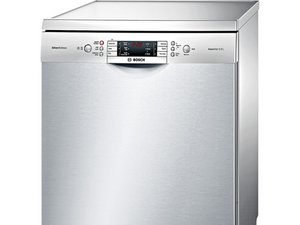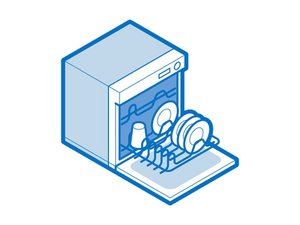Introduction
It's only a matter of time until your dishwasher acquires an unpleasant odor. Trapped food scraps, grease and oil buildup, or standing water can cause bacteria growth and mildew. While we love the smell of clean dishes, we are less partial to an eggy or a burning smell. Let's get your dishwasher back to normal.
Another similar issue is a dishwasher not cleaning. If that problem is more applicable, try the solutions on that page instead.
Causes
Dirty Drain Filter
The filter lives at the bottom of the dishwasher and needs periodic emptying and cleaning. Remove and scrub the filter and screen with soap before replacing. Remove any other large chunks of food from the bottom of the machine.
Food Particles in Soap Scum
Soap scum can act as an adhesive for food particles. Running a cleaning cycle in your dishwasher with distilled white vinegar can neutralize the odors. Add two cups of white vinegar into a dishwasher safe bowl onto the bottom rack of the empty dishwasher. Let the machine air dry at the end of the cycle.
Clogged Spray Arm
The spray arm may have become clogged with food particles. Unclog the holes, and wash with soap. Make sure to clean both upper and lower spray arms. Check the spray arm gaskets and replace if necessary.
Gasket Seals
Mold and mildew can live in the folds of the constantly wet gasket seals. Inspect and clean these seals regularly, especially with the presence of an odor.
Clogged or Kinked Drain Hose
The drain hose transfers fluid from the bottom of your dishwasher to your garbage disposal or under sink drain connection. Solid debris — food, hair, etc — can accumulate in the drain hose with time, but clogs normally form with broken plastic, stickers or porcelain chips.
- Check for a kink in the drain hose that runs from the bottom of your dishwasher to the drain pipe (usually below the sink). Make sure it’s not pinched or kinked. If necessary, replace it with a new hose.
- Check for a clog. Remove the drain hose end from the nipple it's connected to below the sink or disposal, put the end in a bucket, then fill and drain the dishwasher to see if a garbage clog will simply blow out.
- If that doesn't work, but you see a small dribble of water, you may have to pull the dishwasher out and remove the drain hose in order clean it out or replace it.
- Remember, there's still water in the unit—so put a drain pan under it before removing the hose.
- Remove the sump pump screen at the bottom of your dishwasher and remove any materials that shouldn't be there. This screen is usually held in by a couple of screws. Remove the coarse and fine filters and remove all foreign material.
Clogged Air Gap Fitting
After the drain hose leaves the bottom of the dishwasher the hose passes through a loop on the outside of the machine. The hose then travels to an air gap, check valve, or high loop under your sink before connecting to the garbage disposal or under sink drain connector.
Air gaps are a plumbing standard in some locations and optional in others. Check local codes if you're unsure. Without an air gap, there is a small possibility to syphon sewage contaminants into your drinking water system.
- Check your air gap fittings at the sink for any obstructions.
| Air Gap units | High Loop units |
|---|---|
 |  |
Plastic Close to Heating Element
Some pieces of plastic should be run on top shelf only to avoid proximity heating. Additionally, your plastic dishes may have fallen from the top shelf mid-cycle. Pause the cycle and remove the plastic object.
Heating Element
A short circuit may have caused the burning smell. Check the heating element for blisters or raised sections, or if it snapped in half. A multimeter can be used to test continuity in Ohms (Ω). If the meter reads between 0-50Ω, the element has continuity. In the absence of continuity, replace the heating element.
Control Board
In the event of a power surge or component failure, the control board can short out. Inspect the board for burn marks, and replace if burnt.
Power Cord
Overheating cords can melt the coating on the wires. Verify connections on ends of wire are tight and haven't melted or burnt. In the event of damage, unplug machine and replace connections or cord.

- 5 minutesEasy
Your dishwasher was designed to run with a specific soap, and will periodically need cleaning. Performing a routine dishwasher cleaning will help it run in top shape.
You're seeing solutions for Dishwasher. Select your model to find parts for your device.







